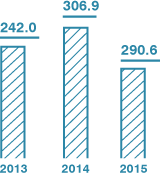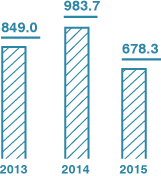Environmental
management
|GRI G4-DMA|
In 2015, inpEV invested R$ 14.9 million in environmental protection. In a business in which the essence is to mitigate environmental impact by means of waste management and material recycling as well as using return shipment to create further positive impacts, inpEV also develops environmental protection actions in its management process to preserve natural resources. |GRI G4-EN27, G4-EN31|
System Benefits (since 2002)
Appropriate packaging disposal avoided:
generation equivalent to
9 years
of waste generated by a
500,000
inhabitant city
consumption of
1.2 million
barrels of oil
emissions of
514,000
tons of CO2e
Source: Espaço Eco foundation
INVESTMENT IN ENVIRONMENTAL |
2013 |
2014 |
2015 |
Waste treatment and disposal |
12,470 |
11,682 |
11,405 |
Incineration of unwashed packagings |
8,460 |
11,072 |
11,405 |
Destination of improper and obsolete products2 3 |
2,990 |
359 |
0 |
Destination of illegal products4 |
686 |
251 |
0 |
Disposal of bags, seeds and sanitary products (pilot project) |
334 |
0 |
0 |
Environmental management and prevention |
3,229 |
3,296 |
3,575 |
Awareness and educational actions5 |
3,090 |
3,145 |
3,384 |
Monitoring actions6 |
139 |
151 |
191 |
Total |
15,699 |
14,978 |
14,980 |
1 Numbers revised in relation to those published in RS 2014. The costs of analyses done on post-consumption resins were not accounted for.
2 In 2013 and 2014, the values refer to programs involving obsolete products in the states of SP & PR.
3 No value has been reported in 2015 since the phase of the obsolete product disposal project has not been started yet in SP, as well as the disposal of improper materials received at the central stations starting this year.
4 The costs associated with the disposal of illegal products were fully transfered to Sindiveg starting in 2015.
5 These include the investments in awareness and education, such as events, the DNCL, materials produced to be used in presentations and field days, besides materials used by multipliers.
6 Monitoring actions after the wash of empty packaging done by producers, including the analyses of water and soil quality, besides related consultancies.
Energy
The campaign to develop collaborator awareness regarding the use of resources, “Responsible Consumption is Sustainable”, monitored electric power consumption, office material, travel expenditures and amount of color printouts.
Electric power consumption at inpEV was 5.31% lower than last year, totaling 290.6 GJ in 2015, of which 202 GJ are from the São Paulo office, 77.72 GJ from the Rondonópolis (MT) station and 10.88 GJ from the Alta Parnaíba (MA) station, which despite having been inaugurated in November, accounted for 12 months of consumption because until then it was operating under an adjustment process. However, the AP consumption was not considered in the 2014 calculation, i.e., considering the same calculation basis, the consumption reduction would reach 8.86%. |GRI G4-EN3|
Energy consumption (GJ) |GRI G4-EN3|

Water
inpEV consumed 678.3 m3 of water during the year, a 31% reduction compared to the 983.7 m3 in 2014, which accounts for the São Paulo office and the Rondonópolis station and informed by the local supply concessionaires. It was not possible to individualize the Taubaté (SP) central station consumption because this unit is in the same area as the Campo Limpo Plastic Transformation and Recycling. The water used at the Alto do Parnaíba station was drawn from an artesian well and its volume was also not accounted for. |GRI G4-EN8|
Water consumption (m3) |GRI G4-EN8|

Emissions
The return shipment concept is a great ally in reducing greenhouse gas (GHG) emissions: the same vehicle that delivers the crop protection products from the industry (manufacturer) to distributors and cooperatives uses the return trip to transport the empty packages, which are returned to the receiving units.
Besides this, manufacturing of the Ecoplástica crop protection packaging, produced by Campo Limpo Plastic Recycling and Transformation, emits four times less greenhouse gases than a conventional package: 0.61 kg of CO2 versus 2.62 kg of CO2e for 20-liter packages. This innovative package offers high resistance and is the first in its category to receive UN certification (group II, 1.4 g/cm3 density) for maritime and ground shipment of hazardous products. |GRI G4-EN19, G4-EN27|
The eighth ecoefficiency study, performed by the Espaço Eco foundation, confirmed the beneficial impact of SCL on the environment. In order to have an idea of this effect, between 2002 and 2015 514,000 tons of CO2 atmospheric emissions were avoided, equivalent to the extraction of 1.2 million barrels of oil. |GRI G4-EN27|
inpEV’s commitment to reduce emissions was ratified in 2015, with its voluntary adhesion to the recently launched Climate Protocol of the São Paulo State Government in November. The purpose of this initiative is to stimulate companies to reduce greenhouse gas emissions and adopt actions to adapt to climate changes. |GRI G4-15, G4-EN19|
